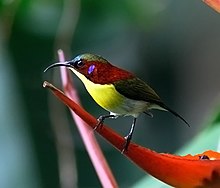The handsome sunbird (Aethopyga bella) is a species of bird in the family Nectariniidae. It is endemic to the Philippines.
| Handsome sunbird | |
|---|---|

| |
| Male | |

| |
| Female | |
| Scientific classification | |
| Domain: | Eukaryota |
| Kingdom: | Animalia |
| Phylum: | Chordata |
| Class: | Aves |
| Order: | Passeriformes |
| Family: | Nectariniidae |
| Genus: | Aethopyga |
| Species: | A. bella
|
| Binomial name | |
| Aethopyga bella Tweeddale, 1877
| |
Its natural habitats are tropical moist lowland forests and tropical moist montane forests.It has a high pitched voice and it sounds like "chik".
Description and taxonomy
editEbird describes it as "A tiny bird of wooded areas from the lowlands to the mountains. Has a fairly long, curved bill, a white belly, an olive wing, and a yellow patch on the back. Male has a yellow throat and chest, a purple ear spot, and a purple mustache stripe tipped with green. Note the green forecrown and pointed tail. Male somewhat resembles Metallic-winged Sunbird and other similar species, but Handsome has a red face and back. The drab female is similar to many other species, but is tiny and relatively short-billed. Voice includes a high-pitched jumbled song and a repeated sharp “chik!”[2]
It was formerly conspecific with the Lovely sunbird but is differentiated by its plain yellow breast versus the Lovely sunbirds red streaking.
Subspecies
editSix subspecies are recognised:
- A. b. bella – – Found in Samar, Biliran, Leyte, , Bohol, Dinagat, and Mindanao
- A. b. flavipectus – Found in North Luzon
- A. b. minuta – Found in Luzon except North, Mindoro. Polillo Islands and Catanduanes
- A. b. rubrinota – Found in Lubang Island
- A. b. bonita – Found in Panay, Masbate, Ticao, Negros and Cebu.
- A. b. arolasi – Found in the Sulu Archipelago[3]
Ecology and behavior
editNot much is known about its diet but it is pressumed to have the typical flowerpecker diet of small fruits, insects, nectar especially from mistletoes. Typically seen singly, pairs, small groups and joins mixed species flocks. Breeding has been recorded on January, June, July and September. Nests were found with 3 eggs but otherwise breeding is unstudied.[4]
Habitat and conservation status
editIts natural habitats are tropical moist lowland forest, montane forest , second growth and plantations up to 2,000 meters above sea level.
The IUCN has classified the species as Least Concern as it has a large range and it is common throughout with the population believed to be stable. However, deforestation in the Philippines continues throughout the country due to slash and burn farming, mining, illegal logging and habitat conversion.
It is found in multiple protected areas such as Bataan National Park, Mount Banahaw, Mount Kitanglad. Mount Apo, Pasonanca Natural Park and Northern Sierra Madre Natural Park but like all areas in the Philippines, protection is lax and deforestation continues despite this protection on paper.
References
edit- ^ BirdLife International (2018). "Aethopyga bella". IUCN Red List of Threatened Species. 2018: e.T22732130A132034102. doi:10.2305/IUCN.UK.2018-2.RLTS.T22732130A132034102.en. Retrieved 13 November 2021.
- ^ "Handsome Sunbird - eBird". ebird.org. Retrieved 2024-09-09.
- ^ Cheke, Robert; Mann, Clive (2020). "Handsome Sunbird (Aethopyga bella), version 1.0". Birds of the World. doi:10.2173/bow.hansun1.01species_shared.bow.project_name. ISSN 2771-3105.
- ^ IUCN (2016-10-01). Dicaeum hypoleucum: BirdLife International: The IUCN Red List of Threatened Species 2016: e.T22717522A94537322 (Report). International Union for Conservation of Nature. doi:10.2305/iucn.uk.2016-3.rlts.t22717522a94537322.en.
